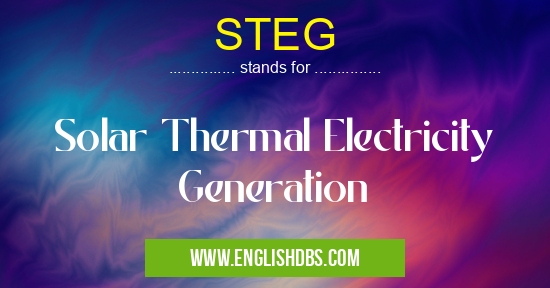What does STEG mean in UNCLASSIFIED
Solar Thermal Electricity Generation (STEG) refers to the process of utilizing concentrated solar energy to generate electricity. This technology involves the use of mirrors or lenses to focus sunlight onto a receiver, which absorbs the heat and converts it into thermal energy. The thermal energy is then used to generate steam, which drives a turbine to produce electricity.

STEG meaning in Unclassified in Miscellaneous
STEG mostly used in an acronym Unclassified in Category Miscellaneous that means Solar Thermal Electricity Generation
Shorthand: STEG,
Full Form: Solar Thermal Electricity Generation
For more information of "Solar Thermal Electricity Generation", see the section below.
STEG Process
1. Sunlight Collection: Mirrors or lenses are strategically positioned to collect and concentrate sunlight onto a receiver.
2. Heat Absorption: The receiver captures the concentrated sunlight and absorbs its heat energy.
3. Thermal Energy Generation: The heat absorbed by the receiver is used to generate thermal energy, typically by heating a fluid (e.g., molten salt or water).
4. Steam Production: The heated fluid transfers its thermal energy to water, converting it into steam under high pressure.
5. Turbine Operation: The high-pressure steam is directed into a turbine, causing it to rotate.
6. Electricity Generation: The rotation of the turbine is connected to an electrical generator, which converts the mechanical energy into electrical energy.
Advantages of STEG
- Renewable Energy Source: STEG utilizes solar energy, an inexhaustible and clean energy source.
- Reduced Greenhouse Gas Emissions: STEG does not produce greenhouse gases, contributing to the mitigation of climate change.
- Baseload Power: STEG systems can operate continuously during daylight hours, providing a reliable baseload of electricity.
- Energy Storage Potential: Thermal energy storage systems can be integrated with STEG plants, allowing for electricity generation even after sunset.
Essential Questions and Answers on Solar Thermal Electricity Generation in "MISCELLANEOUS»UNFILED"
What is Solar Thermal Electricity Generation (STEG)?
STEG is a technology that converts solar energy into electricity using concentrated solar power (CSP). It uses mirrors or lenses to focus sunlight onto a receiver, which heats a fluid to produce steam. The steam is then used to drive a turbine and generate electricity.
How does STEG differ from photovoltaic (PV) solar panels?
Unlike PV systems, which directly convert sunlight into electricity using semiconductor cells, STEG uses a thermodynamic process involving heat transfer and steam generation. STEG systems are typically larger in scale and more efficient at converting sunlight into electricity.
What are the advantages of STEG?
STEG offers several advantages, including:
- High efficiency: STEG systems can achieve conversion efficiencies of up to 40%, compared to 20-25% for PV panels.
- Dispatchability: STEG systems can store thermal energy, allowing them to generate electricity on demand, even when sunlight is not available.
- Scalability: STEG plants can be easily scaled up to meet large-scale electricity needs.
What are the limitations of STEG?
STEG faces some limitations, such as:
- High cost: STEG plants require significant upfront capital investment.
- Geographic constraints: STEG systems require large areas of land with high levels of direct sunlight.
- Water consumption: STEG systems require water for cooling purposes, which can be a concern in arid regions.
What is the future of STEG?
STEG is expected to play a significant role in the transition to renewable energy. With technological advancements and cost reductions, STEG systems are becoming more competitive and are expected to contribute to meeting global electricity demand.
Final Words: STEG is a promising technology for electricity generation that harnesses the abundant power of the sun. Its ability to produce clean, renewable, and baseload power makes it an attractive option for combating climate change and meeting the growing demand for energy. As research and development continue, STEG is expected to become increasingly efficient and cost-effective, making it a key player in the transition to a sustainable energy future.
